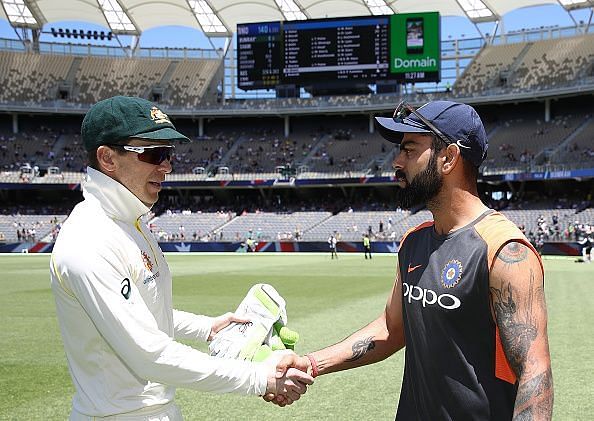
The stump mic debate goes on: Pros and cons of keeping the stump mic on

"You can’t seriously like Virat Kohli as a bloke" joked the Australian skipper and wicket-keeper Tim Paine when the Indian opener Murali Vijay was batting. Paine and Kohli traded barbs on day three and four of the recently concluded Perth Test match, all of which was caught by the stump mics and broadcasted by the organizers.
The above conversations along with Indian wicket-keeper Rishabh Pant mocking Pat Cummins from behind the stumps and the Ishant-Jadeja spat have spiced up the India tour of Australia. These recordings from the stump mics have set the social media on fire and have garnered tremendous media attention.
As a result, having the stump mics turned on loud even in between the balls and overs has become a topic of debate amongst the fans and the experts. Earlier this year the ICC, in its new guidelines, permitted stump mics to be turned up throughout the game.
The pros of keeping the stump microphones up throughout:
#1 Keeps the viewers hooked
Witty comments, sledging, and a bit of teasing heard over the stump mic is riveting and attracts more viewers. The fans take it on to the social media and in no time one can find the social media space flooded with tweets and trolls, posts and comments, and a series of side-splitting memes. As a result, viewership increases many folds which is a win-win situation for the broadcasters and the game of cricket as well.
#2 Useful Insights
Listen to the sharp-witted MS Dhoni from behind the stumps, conveying his ingenious plans to the bowlers and the fielders, and you will know exactly what is going on his mind.
Stump mics get the viewers closer to the game. They can listen to discussions between the players especially the bowler and the keeper. These insightful discussions help fans to understand the game better and enjoy it more.
#3 Useful to identify improper, unlawful, or obscene comments
Often in an intense encounter, a simple banter turns ugly and results in inappropriate and unacceptable words being exchanged between the players involved. In this gentleman's game, such behaviour is regarded as unlawful and punishable. Thus, keeping the microphones on all the time helps the match officials to pick such things up and reprimand the players accordingly.
The cons of keeping the stump microphones up throughout:
#1 Painting a bad image on the players or the team
The recent spat between Jadeja and Ishant, the war of words between Kohli and Paine, a series of abuses between players during the Australia tour of South Africa have all marred the image of the players and the teams involved.
Many players feel that although stump mics do play an important role in maintaining the decorum, sometimes the players which are involved, get dragged far too much into it. These players are severely trolled on social media and are also grilled in post-match press conferences by the media reporters.
Such things can have serious negative consequences on a player's game.
#2 Biased broadcasters
Often it has been observed that broadcasters ask the commentators to keep quiet when players from the visiting team are talking in the vicinity of the mic so that they can raise the volume and these players can be targeted.
It was first reported by the Australian team when they visited South Africa earlier this year. The Aussies later employed an innovative marketing gimmick when they were standing close to the stumps and mocked the South African broadcasters.
Ironically, in the ongoing series too, it has been observed that commentators were asked to stay quiet when Ashwin was bowling and Rishabh Pant was teasing Pat Cummins.
What do the experts say?
The experts are broadly divided into two categories. 'Anti-sledging group' - experts who feel sledging is against the core principles of the game and the 'pro-sledging group' - experts who feel that until the line is not crossed, sledging makes the game of cricket more fierce, competitive and entertaining.
A few from the anti-sledging group feel that the stump mics should be turned down so that sledging does not get promoted whereas the rest feel that the microphones could help to control the foul language.
A similar split can be seen in the 'pro-sledging' group as well. Some feel that whatever happens on the field should stay on the field whereas some feel that it adds to the entertainment value and should be broadcasted.
What next?
As far as the ICC is concerned, the stump mics will stay on and loud even when the ball is dead. Thus it is ICC's responsibility to make sure that the broadcasters use it as a tool for viewer engagement and not to blemish a player's or a team's image.
The conversations and comments captured by the stump mics are all set to get spicier during the remainder of the series as both teams have everything to play for and energy levels would be at its zenith.